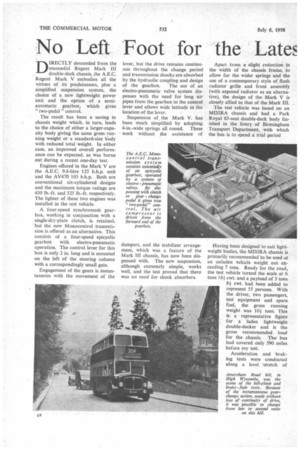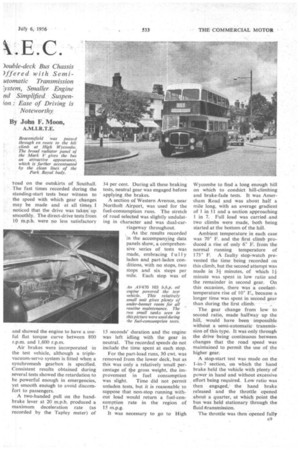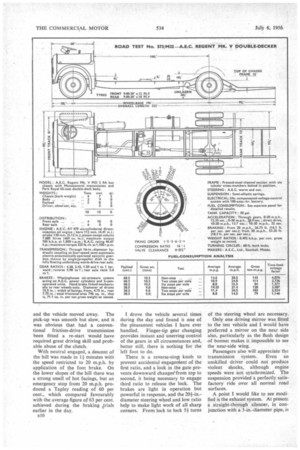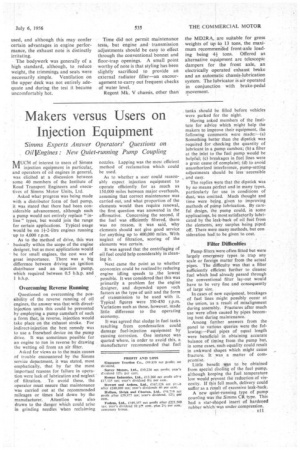No Left Foot for the Lates
Page 56

Page 57

Page 58

Page 59

If you've noticed an error in this article please click here to report it so we can fix it.
)ouble-deck Bus Chassis )ffered with Semiutomatic Transmission ;ystem, Smaller Engine nd Simplified Suspenfon : Ease of Driving is Noteworthy, By John F. Moon,
A.M.I.R.T.E. DIRECTLY descended from the successful Regent Mark III double-deck chassis, the A.E.C. Regent Mark V embodies all the virtues of its predeCessors, plus a simplified suSpension system, the choice of a new lightweight power unit and the option of a semiautomatic gearbox, which gives " two-pedal " control.
The result has been a saving in chassis weight which, in turn, leads to the choice of either a larger-capacity body giving the same gross running weight or a standard-size body with reduced total weight. In either case, an improved overall performance can be expected, as was borne out during a recent one-day test.
Engines offered in the Mark V are the A.E.C. 9.6-litre 125 b.h.p. unit and the AV470 103 b.h.p. Both are conventional six-cylindered designs and the maximum torque ratings are 430 lb.-ft. and 325 lb.-ft. respectively. The lighter of these two engines was installed in the test vehicle.
A four-speed synchromesh gearbox, working in conjunction with a single-dry-plate clutch, is retained, • but the new Monocontrol transmission is offered as an alternative. This consists of a four-speed epicyclic gearbox with electro-pneumatic operation. The control lever for this box is only 2 in. long and is mounted on the left of the steering column with a correspondingly small gate. Engagement of the gears is instantaneous with the movement of the lever, but the drive remains continuous throughout the change period and transmission shocks are absorbed by the hydraulic coupling and design of the gearbox. The use of an electro-pneumatic valve system dispenses with the need for long air pipes from the gearbox to the control lever and allows wide latitude in the location of the lever.
Suspension of the Mark V. has been much simplified by adopting 4-in.-wide springs all round. These work without the assistance of dampers, and the stabilizer arrangement, which was a feature of the Mark III chassis, has now been dispensed with. The new suspension, although extremely simple, works well, and the test proved that there was no need for shock absorbers. Apart from a slight reduction in the width of the chassis frame, to allow for the wider springs and the use of a contemporary style of flush radiator grille and front assembly (with exposed radiator as an alternative), the design of the Mark V is closely allied to that of the Mark HI.
The test vehicle was based on an MD2RA chassis and had a Park Royal 65-seat double-deck body finished in the livery of Birmingham Transport Department, with which the bus is to spend a trial period Having been designed to suit lightweight bodies, the MD2RA chassis is primarily recommended to be used at an unladen vehicle weight not ex ceeding 7 tons. Ready for the road, the test vehicle turned the scale at 6 tons 16+ cwt. and a payload of 3 tons 8+ cwt. had been added to represent 55 persons. With the driver, two passengers, test equipment and spare fuel, the gross running weight was 101 tons. This is a representative figure for a laden lightweight double-decker and is the gross recommended load for the chassis. The bus had covered only 590 miles before my test.
Acceleration and braking tests were conducted along a level "stretch of Toad on the outskirts of Southall. The fast times recorded during the standing-start tests bear witness to the speed with which gear changes may be made and at all times I noticed that the drive was taken up smoothly. The direct-drive tests from 10 m.p.h. were no less satisfactory and showed the engine to have a useful flat torque curve between 800 r.p.m. and 1,600 r.p.m.
Air brakes were incorporated in the test vehicle, although a triplevacuum-servo system is fitted when a synchromesh gearbox is specified. Consistent results obtained during several tests showed the retardation to be powerful enough in emergencies, yet smooth enough to avoid discomfort to passengers.
A two-handed pull on the handbrake lever at 20 m.p.h. produced a maximum deceleration rate (as recorded by the Tapley meter) of 34 per cent. During all these braking tests, neutral gear was engaged before applying the brakes.
A section of Western Avenue, near Northolt Airport, was used for the fuel-consumption runs. The stretch of road selected was slightly undulating in character and was dual-carriageway throughout.
As the results recorded in the accompanying data panels show, a comprehensive series of tests was made, embracing fully laden and part-laden conditions, with no stops, two stops and six stops per mile. Each stop was of 15 seconds' duration and the engine was left idling with the gear in neutral. The recorded speeds do not include the time spent at each stop.
For the part-load runs, 30 cwt. was removed from the lower deck, but as this was only a relatively small percentage of ttie gross weight, the improvement in fuel consumption was slight. Time did not permit unladen tests, but it is reasonable to suppose that non-stop running without load would return a fuel-consumption rate in the region of 15 m.p.g.
It was necessary to go to High Wycombe to find a long enough hill on which to conduct hill-climbing and brake-fade tests. It was Amersham Road and was about half a mile long, with an average gradient of 1 in 11 and a section approaching 1 in 7. Full load was carried and two climbs were made, both being started at the bottom of the hill.
Ambient temperature in each case was 70° F. and the first climb produced a rise of only 6° F. from the normal running temperature of 173° F. A faulty stop-watch prevented the time being recorded on this climb, but the second attempt was made in 31 minutes, of which 1 minute was spent in low ratio and the remainder in second gear. On this occasion, there was a coolanttemperature rise of 10° F., because a longer time was spent in second gear than during the first climb.
The gear change from low to second ratio, made halfway up the hill, would have been impossible without a semi-automatic transmission of this type. It was only through the drive being continuous between changes that the road speed was maintained to permit the use of the higher gear.
A stop-start test was made on the
1-in-7 section, on which the hand brake held the vehicle with plenty of power in hand and without excessive effort being required. Low ratio was then engaged, the hand brake released and the throttle opened about a quarter, at which point the bus was held stationary through the fluid transmission.
The throttle was then opened fully and the vehicle moved away. The pick-up was smooth but slow, and it was obvious that had a conventional friction-drive transmission been fitted a re-start would have required great driving skill and probable abuse of the clutch.
With neutral engaged, a descent of the hill was made in 1.1 minutes with the speed restricted to 20 m.p.h. by application of the foot brake. On the lower slopes of the hill there was a strong smell of hot facings, but an emergency stop from 20 m.p.h. produced a Tapley reading of 60 per cent., which compared favourably with the average figure of 63 per cent. achieved during the braking trials earlier in the day.
E 1 0 I drove the vehicle several times during the day and found it one of the pleasantest vehicles I have ever handled. Finger-tip gear changing provides instant and unerring control of the gears in all circumstances and, better still, there is nothing for the left foot to do.
There is a reverse-stop( knob to prevent accidental engagenient of the first ratio, and a lock in the gate prevents downward changeffrom top to second, it being necessary to engage third ratio to release the lock. The brakes are light in operation but powerful in response, and the 201-in.diameter steering wheel and low ratio help to make light work of all sharp corners. From lock to lock 5/ turns of the steering wheel are necessary.
Only one driving mirror was fitted to the test vehicle and I would have preferred a mirror on the near side also, particularly as the flush design of bonnet makes it impossible to see the near-side wing.
Passengers also will appreciate the transmission system. Even an unskilled driver could not produce violent shocks, although engine speeds were not synchronized. The suspension provided a perfectly satisfactory ride over all normal road surfaces.
A point I would like to see modified is the exhaust system. At present a straight-through silencer, in conjunction with a 3-in.-diameter pipe, is used, and although this may confer certain advantages in engine performance, the exhaust note is distinctly irritating.
The bodywork was generally of a high standard, although, to reduce weight, the trimmings and seats were necessarily simple. Ventilation on the upper deck was not entirely adequate and during the test it became uncomfortably hot. Time did not permit maintenance tests, but engine And transmission adjustments should be easy to effect through the conventional bonnet and floor-trap openings. A small point worthy of note is that styling has been slightly sacrificed to provide an external radiator filler—an encouragement to carry out frequent checks of water level.
Regent Mk. V chassis, other than
the MD2RA, are suitable for gross weights of up to 13 tons, the maximum recommended front-axle loading being 4i tons. Offered as alternative equipment arc telescopic dampers for the front axle, an electrically operated exhaust brake and an automatic chassis-lubrication system. The lubricator is air operated in conjunction with brake-pedal movement.
























































































































